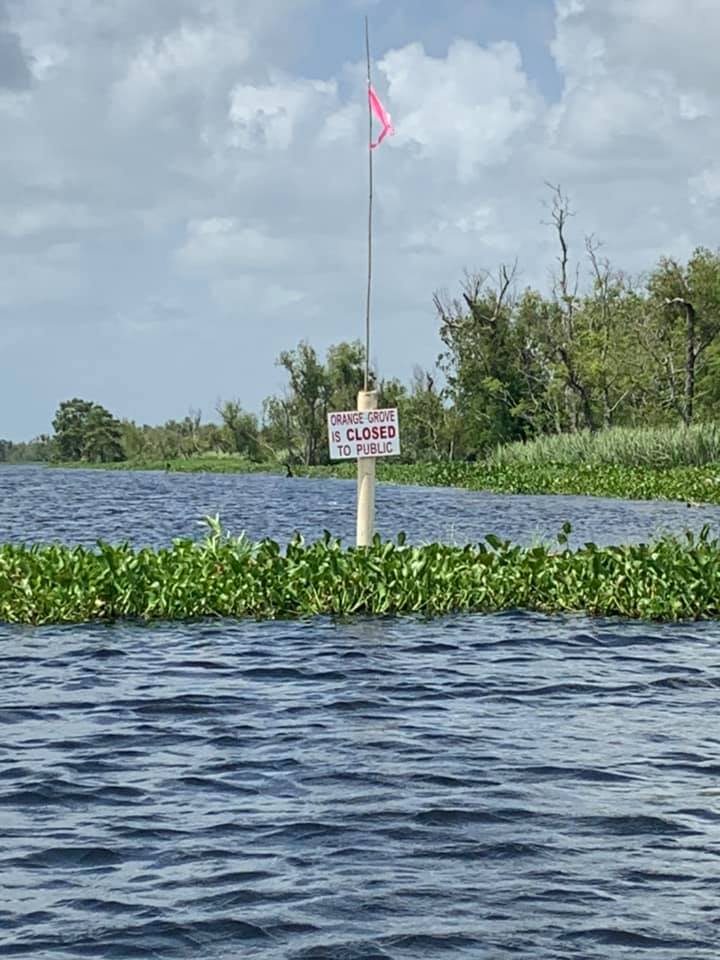
Ochsner Health Announces Community COVID-19 Testing June 3 in Thibodaux
May 29, 2020
HPD announces DWI Checkpoint in Houma on Tuesday
May 29, 2020A sign was recently posted in Orange Grove, a popular freshwater fishing spot in the Bayou Black area, that reads, “Orange Grove is closed to the public.”
However, what is worrying local fishermen even more is the possibility of the installation of gates that could completely cut off the public from the area’s canals.
“It is definitely one of the most popular fishing destinations in the area,” said Lucas Ragusa, Secretary of the Louisiana Sportsmen’s Coalition (LASC), a non-profit organization dedicated to protecting public access to Louisiana waterways.
The man-made canals were dug for oil and gas exploration, Ragusa explained, and by digging the canals, they cut through some of the marsh areas.
“It was common knowledge that if you were in the canal, you were fine. If you were in the marsh, they would ask you to leave. Some would go about it differently than others,” he continued. “Now they won’t even let us in the canal complex.”
In Louisiana, individuals and corporations are allowed to own the water bottoms of large areas of water, and with that ownership, they have the ability to not allow the public to traverse the water above. Louisiana is the only state in the country with such laws that allow private restrictions to tidal waters.
“The problem that we have is that the state owns the resource; the water and all of the contents in it belong to the state of Louisiana,” Ragusa said. “And so by them limiting our access by getting off the canal, we can no longer catch fish in those areas. We can’t even attempt to.”
Another issue the LASC has with the gates in Orange Grove is that it has yet to be approved by the U.S. Army Corps of Engineers, as Ragusa explained: ”There’s probably 150 gates all over Louisiana that we believe are illegally installed and did not have proper authority from the Corps of Engineers and the United States Coast Guard. And because of that, they’re navigation hazards.”
“If it is not correctly installed where it’s lit and people can see that it is an obvious obstruction, it’s possible that somebody could run into it and seriously hurt themselves or even kill themselves,” he continued. “So if they’re going to do it, we are going to make sure that when they do it, they are done correctly.”
The permit to install the gates was approved by Mart Black, Director of Terrebonne Parish Office of Coastal Restoration & Preservation.
Black granted the permit without holding a public hearing or putting it on the agenda for the Coastal Zone Management and Restoration Advisory Committee to discuss due to the cancellation of meetings the pandemic caused. He said the proper protocols were followed, however.
“A coastal use permit application was submitted to the Office of Coastal Management of the Department of Natural Resources and subsequently sent to the Corps of Engineers,” Black said. “The Office of Coastal Management deemed that permit to be a local concern, not a state concern. So, it comes to me.”
He reviewed all the drawings for the project, assessed the wetland impacts and determined the impacts were well beneath the threshold for compensatory mitigation, Black said, and also had the Office of Coastal Management review the plans as well, who made the same determination.
“On that basis, we said, ‘There’s no wetland impacts, so we’re going to issue the permit,’” he said. “We don’t have anything to do with gates, per se, on canals; that’s a property owner issue. We only look at those impacts that those gates would cause during their installation, and really there were not any impacts.”
Black also noted the permit was published for public notice in March and it didn’t receive any written negative comments regarding the project prior to his decision.
He doesn’t know the status of the permit with the Corps of Engineers, Black said.
The permit application, which can be found here, is on the agenda for the Coastal Zone Management and Restoration Advisory Committee meeting on June 2 at the Regional Military Museum, but Black said it’s more or less for them to review since the permit has already been granted by his office.
“If this was coming up for the first time at a regular meeting, I think they’d be in a difficult position because we don’t have any jurisdiction over gates,” he said. “That’s an issue for the legislature to solve.”
Black and Ragusa both expect a decent showing by the public at the meeting to speak out against the permit. (The general public will be limited to 44 seats at the meeting due to a 25 percent occupancy limit and social distancing. Those who attend will also need to wear face masks and have their temperature screened before entering the building. The meeting will be live-streamed on the Terrebonne Parish Consolidated Government Facebook Page.)
“I can see their point of view, but it seems like that’s something the courts are going to have to decide at some point. I can’t decide that; I don’t do that here,” Black said. “Blocking a canal with a gate: I hate to see that. But there’s really not a lot I can do about that.”
Ragusa said 80 percent of the water in Louisiana has private ownership.
“We’re trying to get people to understand a little bit more about what’s going on. It is affecting the people of Terrebonne Parish more than it is anywhere else just because it’s one of the places where it started earliest. But it is a statewide issue,” Ragusa said.
“You should have zero rights in order to impede on our access because when we buy a fishing license, we feel like the fishing license gives us the permit to go after the resources of the state,” he added. “We are doing everything we can to fight for public water access.”
More on the LASC can be found here.
Photo courtesy of social media.











